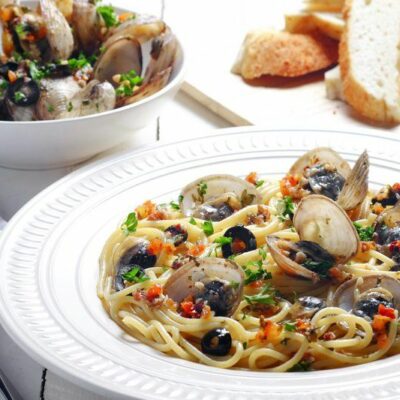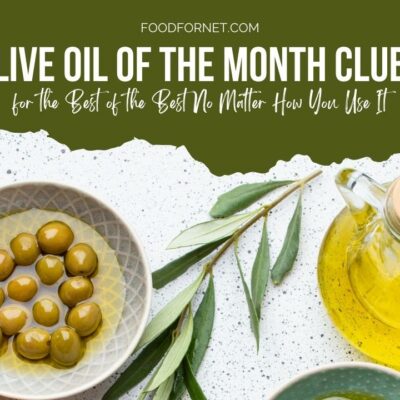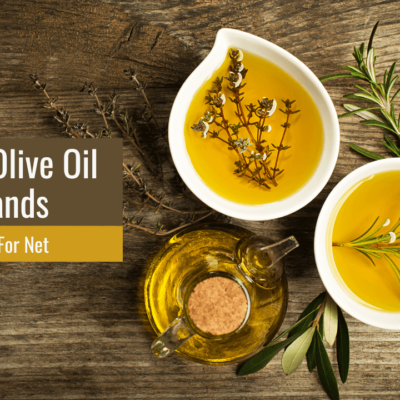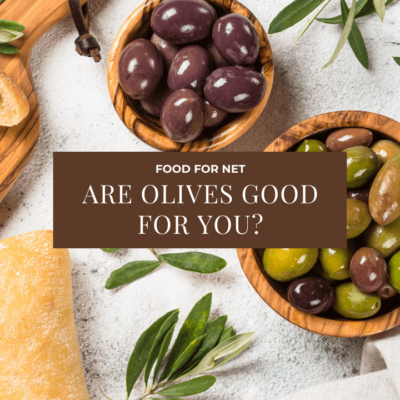
When we talk about healthy oils, olive oil is often top of the list. This is hardly surprising, as the oil features heavily in healthy Mediterranean diets and is well-known as a healthy fat. So, when should you use it and is olive oil good for you?
With olive oil’s stellar reputation, asking about its health benefits might seem a little strange. Still, the topic is an important one, as the intersection between food and health is always complex. Most foods have some positive features and some less appealing ones.
To begin with, let’s talk about the oil itself.
Olive oil is created by pressing whole olives, often with minimal refinement or processing. As such, olive oil retains many of the important nutrients from olives. The oil is commonly used in cooking or on salads, and is just as important in cosmetics, skincare products, and even as a type of lamp oil.
Continued high demand for the oil means that it is now produced in large quantities in many places. However, product quality can vary dramatically, so consumers need to choose products carefully. You’ll get more benefits from a high-quality bottle of olive oil than from an inferior one.
Is Olive Oil Good For You?
- Why Olive Oil Is So Beneficial
- Olive Oil Nutrition
- Where Olive Oil Performs Less Well
- Which Type Of Olive Oil Is Best?
- What About Olive Oil Spreads?
- Can You Cook With Olive Oil?
- Should You Drink Olive Oil?
- Final Thoughts
Why Olive Oil Is So Beneficial

It’s Natural
Many of the cooking oils that we use daily have been heavily refined. The process changes some of the properties of the oils, while often altering the flavor and consistency as well.
Such changes could be damaging to health. These days, there’s a growing focus on returning to natural ingredients whenever possible. Olive oil is one of these.
In fact, extra virgin olive oil is simply made by pressing oil from olives. What could be simpler?
The Monounsaturated Fats
Olive oil also has a fantastic balance of fats. It’s roughly 78% monounsaturated fat and 14% saturated fat. Monounsaturated fats are thought to be the healthiest type of fat, offering more benefits and fewer risks than fats. They’re the ones associated with long life and they feature heavily in the Mediterranean diet, along with similar eating approaches.
The low saturated fat content is good too.
Remember, saturated fat is often thought to increase levels of bad cholesterol and raise heart disease risk. This topic is under intense debate, with evidence on both sides of the argument.
Still, even if saturated fat isn’t as bad as we’re often told, it seems wise to focus on low saturated fat foods and oils as much as we can. Replacing saturated fat with monounsaturated fat wherever possible could also help to decrease heart disease risk.
It Has Been Linked To Many Benefits
You’ve probably heard about the benefits of olive oil. These are strongly linked to the monounsaturated fats, along with beneficial compounds from olives. For example, olive oil may help to improve heart health, decrease pain, and even promote weight loss.
The pain relief effect comes from a compound called oleocanthal. This can suppress the pathways that cause pain, much like pain reliever medication. While the effect isn’t nearly as strong as a painkiller, it could still be relevant for anyone suffering chronic pain who wishes to avoid medication.
Still, simply adding olive oil to your diet mightn’t be enough. The studies that highlight these benefits often focus on diets that are rich in olive oil (particularly the Mediterranean diet), rather than directly looking at olive oil consumption.
This suggests that you might need to move towards a plant-heavy diet and cut down on saturated fat intake too.
Has Antioxidant And Anti-Inflammatory Effects
Oxidation and inflammation have become hot topics in recent years. These are both important processes in our body, but can easily become out of balance. Too much oxidative stress or inflammation is harmful, potentially leading to increased disease risk.
Olive oil is an excellent way to combat these issues, as it has both anti-inflammatory and antioxidant properties. The anti-inflammatory effects are a further reason why olive oil could help to decrease pain.
Olive Oil Nutrition

Olive oil is made up of fat, making it free from carbs and protein. It doesn’t contain many nutrients either, although it is a notable source of vitamin E and vitamin K.
While both of these vitamins offer health benefits, the vitamin E could be a problem if you’re having large amounts of olive oil at a time, as it’s possible to have too much of the vitamin.
As for fats, olive oil mostly made up of monounsaturated fats, including palmitoleic acid and oleic acid.
Omega-3 and omega-6 fatty acids are present too, in an appealing ratio. As such, olive oil isn’t an omega-6 rich food and is perfect for an anti-inflammatory diet.
Where Olive Oil Performs Less Well
The first issue with olive oil is that it’s still a type of fat. This means that it’s high in calories – with a single tablespoon containing around 120 calories. That’s a lot of calories and it’s very easy to overdo it.
After all, you’re often drizzling olive oil over salads or using it for dipping, rather than measuring it out. The effects of using even a little more than you intend to each time would add up quickly.
High calorie foods can be a problem when you’re trying to stay at a healthy weight. You might even need to cut down your calories somewhere else so you can fit olive oil into your diet.
Its Smoke Point And Melting Point
Olive oil has a low melting point, so it isn’t solid at room temperature like butter or margarine. This means that you can’t easily spread it on toast. Of course, the liquid nature of olive oil makes it perfect for drizzling over a salad, so this feature has its advantages too.
The smoke point is also on the low end for a cooking oil. For extra virgin olive oil, you’re looking at around 405˚F, while virgin olive oil is closer to 410˚F, and refined olive oil can vary dramatically.
With these smoke points, you probably wouldn’t use olive oil for deep frying or very high temperature cooking. We’ll talk more about the idea of cooking with olive oil a little later on.
Olive Oil Fraud
Fraud is a huge problem for the olive oil industry. The oil is popular, fetches a high price, and can be expensive to produce, all of which provides fraudsters with plenty of incentive.
And, unfortunately, olive oil can be easily adulterated. This means that instead of selling pure olive oil, some companies mix cheaper oils in as well. The distinct flavor of olive oil easily masks the other oils, making it almost impossible to work out whether you have the real deal or not.
Some companies use a blend of virgin and extra virgin olive oil instead, along with ones that add refined olive oil in the mix too. Some of these products will be marketed as extra virgin olive oil – and you might pay a lot for olive oil that isn’t what it claims to be.
Olive oil often isn’t tested regularly, especially not in America, so it’s easy for companies to get away with the practice.
When buying olive oil yourself, take the time to look for high-quality products. The companies will often provide details about the harvest date of the olives, the cultivar that the olives come from, and specifically where the olive oil was made.
You can also look for specialty olive oil stores. These can provide the chance to taste the olive oil before you buy it. Plus, the company should have done some legwork to make sure that the olive oil lives up to its claims.
The Potential For Contaminants
There’s also the chance for contamination. This could come from contaminants during growing, manufacturing, or other parts of olive oil creation. Examples include pesticides, mycotoxins, and phthalates.
Now, contaminants aren’t an unusual problem. They can potentially be present for anything that is grown or manufactured.
However, this is a notable area of concern for olive oil, as plenty of companies are producing low-quality oil and trying to pass this off as virgin or extra virgin olive oil.
The best way to avoid this problem is to focus on reputable olive oil producers, ones that provide plenty of information about their processing steps and where the olives are grown. Most such companies will pay close attention to their products and make sure that the olive oil is as healthy as it can be.
The Price
Olive oil is one of the most expensive oils. The price is particularly high if you want extra virgin olive oil. This feature could be a deal breaker for some families, especially if you use oil often.
You can reduce the issue by having multiple types of oil in the house and choosing the best type for the occasion. For example, olive oil is the ideal choice in many salads, tossed through pasta, or in a dressing, while you can easily use other types of oil for cooking.
Which Type Of Olive Oil Is Best?

There are a few different types of olive oil, starting with the well-known extra virgin olive oil. This type is made from the first pressing of olives and generally uses cold pressing techniques.
While extra virgin olive oil is the most expensive type, it can also contain more beneficial compounds than any other type of olive oil. Extra virgin olive oil also has the strongest flavor, so it’s perfect if you’re using the oil for dipping, garnishing, or in a dressing.
Virgin olive oil is the next step down. It is made from the second pressing of the olives, which gives it a milder flavor and fewer beneficial compounds.
Still, virgin olive oil tends to be unrefined and is often more affordable than extra virgin. It also has a higher smoke point, which may be relevant if you’re planning to cook with the oil.
Light olive oil is something different. This type isn’t lower in calories at all. Instead, it has a milder flavor. The mild flavor can be appealing, but this type of olive oil is often a combination of refined olive oil and virgin olive oil. Because of this, the olive oil doesn’t offer the same health benefits as the earlier types.
You may see other olive oils too. The term pure is sometimes used or even just olive oil. Such olive oils will often be refined or they may be a combination of refined and unrefined oils.
Virgin and extra virgin are easily the best types. They both avoid refinement and provide plenty of beneficial compounds from olives. While extra virgin olive oil is the ideal option, virgin olive oil is fine if you’re on a budget.
What About Olive Oil Spreads?
Olive oil spreads are an interesting alternative to butter. As the name suggests, this type of product is a margarine-like spread that is made from olive oil.
The advantages are easy to see. With these spreads, you’re getting a healthy balance of fats, including plenty of monounsaturated and polyunsaturated fats. The saturated fat content is much lower than you find in butter, while there aren’t any of the trans fats from margarine to worry about either.
Of course, these spreads do often taste like olive oil rather than butter, so the experience isn’t as delicious as smearing butter on your bread.
The amount of processing varies depending on the product. Some use chemical techniques and additives to make the spread taste more like butter. This type of processing can decrease the benefits.
You can get around issues of processing by making your own olive oil spread. The simplest option is to pour olive oil into a freezer-proof container and freeze it. You could even mix in some herbs or crushed garlic to provide extra flavor.
Doing so lowers the temperature enough to let the olive oil solidify. You can then use it as a spread. This type of homemade olive oil spread will quickly turn back to liquid at room temperature, so you can’t keep it out of the freezer for long.
Can You Cook With Olive Oil?

While olive oil is healthy, using it as a cooking oil can be tricky. For one thing, it has a lower smoke point than most other cooking oils. You can still cook with it, even over a high heat, but you’ll need to watch carefully to make sure that nothing burns.
There’s also concern about toxic compounds that are released during cooking.
Thankfully, there’s little evidence that this actually happens, despite olive oil’s low smoke point. The high antioxidant content appears to protect the oil, so dangerous compounds aren’t formed. Olive oil may even be safer at higher temperatures than many other types of cooking oil.
Of course, olive oil won’t always be the best choice. It has a strong flavor that won’t complement all meals.
If you do cook with oil, you still need to avoid the smoke point. Hitting this isn’t dangerous per se, but some of the beneficial compounds start to break down after you hit the smoke point and the olive oil doesn’t taste as good either.
The smoke point is lowest for extra virgin olive oil and becomes higher the more refined the olive oil is. And, even refined olive oil isn’t the best for cooking at very high heat, like deep frying or searing meat. For those uses, look for an oil with a higher smoke point.
Should You Drink Olive Oil?
Olive oil is normally used as an ingredient or a cooking oil. Still, some people suggest that you should drink it instead.
In one sense, drinking olive oil makes sense. The idea is simply a different way to get access to the healthy compounds that we highlighted earlier. Still, why not just use olive oil with your food instead?
Plus, olive oil is more useful when you consume it with foods because, as a source of fat, it can improve absorption of fat-soluble nutrients and some antioxidants. This is why cooking kale in a little olive oil is more nutritious than eating raw kale on its own.
If you feel like drinking the oil – pay close attention to the amount that you consume. Even a small glass of the oil will probably be too much. Remember, a single tablespoon of olive oil contains around 120 calories. For most people, just one tablespoon might be enough (or even more than enough).
Final Thoughts

Olive oil is a source of monounsaturated fats and has been linked to many benefits. It’s clearly good for you, provided that you’re following a healthy diet as well.
The biggest problems don’t come from olive oil itself. Instead, you may face challenges in finding affordable high-quality olive oil that hasn’t been adulterated or refined. For some people, the price of olive oil could make it best as an occasional ingredient, rather than something that you use every day.
Still, the benefits of the oil make it worth including in your diet whenever you can.
Frequently Asked Questions
How Long Is Olive Oil Good For?
Bottled olive oil has a shelf life of somewhere between 18 to 24 months. While that’s a decent figure, it’s based on when the oil was initially bottled, rather than when you buy it.
Some bottles will have been shipped internationally, then sit waiting on a grocery store shelf. As such, your olive oil might be a decent way through its shelf life before you even bring it home.
And remember, 18 to 24 is the figure for an unopened bottle of olive oil. Once the oil is open, it’s best to use it within a month or two.
If the olive oil is past its date and hasn’t gone rancid, you should still be able to use it without a problem. Once the oil has gone rancid, it’s time to get rid of it (you can technically still use rancid olive oil, but it has lost most of its beneficial antioxidants and tastes weird, so why would you want to?).
How Many Calories In A Tablespoon Of Olive Oil?
A tablespoon of oil contains roughly 119 calories. The calorie content can vary slightly from product to product, but the differences are minimal.
This figure is roughly the same for many other oils too, like canola oil and avocado oil, as they’re all pure fat.
Is Olive Oil A Vegetable Oil?
Olive oil is sometimes called a vegetable oil, largely because vegetable oil is sometimes defined as any oil that comes from a plant. It’s a misleading name though, as olive oil is extracted from olive fruits, rather than from any type of vegetable.
Does Frying With Olive Oil Cause Cancer?
If you bring any cooking oil past its smoke point, then some potentially carcinogenic compounds are produced. However, olive oil is a surprisingly good choice for frying, as it has a relatively high smoke point and decent oxidative stability.
To protect yourself further, simply make sure you don’t make your oil smoke. It’s not like you want it to smoke anyway, as that compromises the flavor.
Is Olive Oil Fattening?
In one sense, yes, as oils are pure fat, so the calorie content per serving is high. However, we need some fat in our diet and avocado oil is one of the healthiest options.
And, despite what we’ve long been taught – fat isn’t the villain. Having the right amount of fat in your diet can even help with weight loss as it is satisfying.

















 The Best Mezcal For Every Budget
The Best Mezcal For Every Budget
Leave a Reply